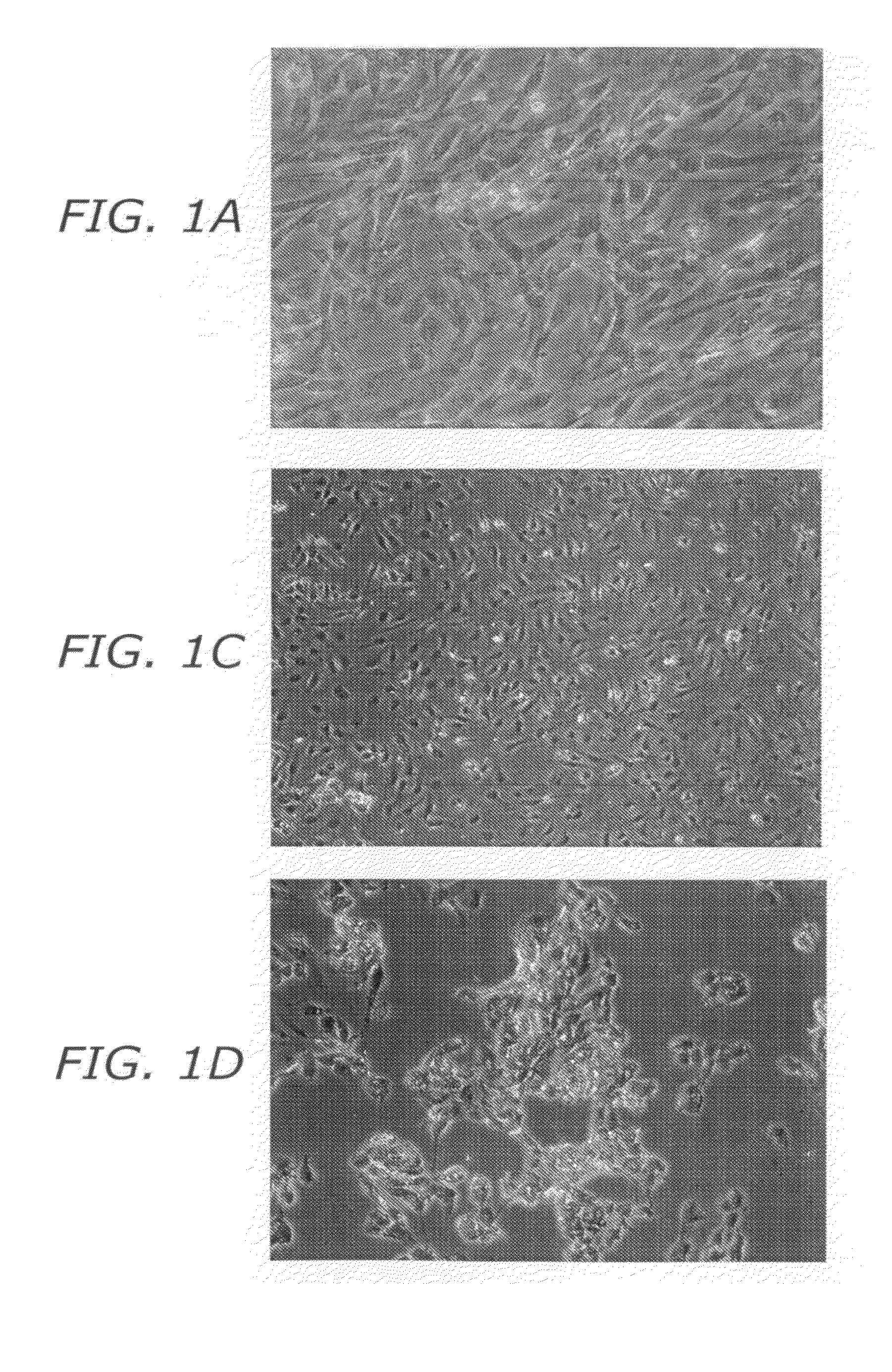Non-viral delivery of transcription factors that reprogram human somatic cells into a stem cell-like state
a technology of transcription factors and stem cells, applied in the field of reprogrammed cells, can solve the problems of reducing the number of types, reducing the immunological privilege of cells, and presently not considered a desirable therapeutic option for genetic modification, so as to facilitate the entry of at least one pluripotency factor and facilitate the entry of said factor
- Summary
- Abstract
- Description
- Claims
- Application Information
AI Technical Summary
Benefits of technology
Problems solved by technology
Method used
Image
Examples
example 1
The HT NP-RFP / OP-GFP Cell Line
[0142]Effects of potential reprogramming factors and treatments can be difficult to assess in tissue culture. ESC-like morphological changes can take days or weeks to manifest themselves and are not always indicative of pluripotency. An unbiased cellular reporter system was constructed based on the assumptions that: (i) transcription factor Oct-4 is key to inducing down-stream gene expression on the pathway of therapeutic reprogramming to an ESC-like state in adult cells; (ii) Nanog activation by Oct-4 is a most important key to inducing this adult cell therapeutic reprogramming; (iii) exogenous Oct-4 is likely not sufficient to induce therapeutic reprogramming without activation of endogenous Oct-4 expression; and, (iv) the optimal effects of these two transcription factors are most easily viewed in the context of a receptive cellular genetic and epigenetic background, i.e., as present in human testicular cells (HT; as disclosed in PCT / US2006 / 004077, f...
example 2
Single Wall Nanotube-Mediated Delivery
[0147]The ability of very small carbon single wall nanotubes (SWNT) to deliver large proteins into cells was tested to determine whether, if sufficiently small, the SWNT might bypass endocytic routes of entrance and, if appropriately charged, they might adhere to proteins.
[0148]In order to “clear” the SWNT (Lythmus Nanotechnology), a SWNT solution at 2 mg / ml was first autoclaved in a liquid cycle for 30 min and then centrifuged at 6,000 rpm in a microcentrifuge for 5 min to remove clumps and debris. The “cleared” supernatant was used for subsequent experiments.
[0149]The potential ability of SWNT to deliver large proteins into cells via a non-endosomal and endosomal penetration was tested as follows:
[0150]1. 1 mg / mL of cleared nanotubes were mixed with 1 μg / mL IgG labeled with GFP green fluorescent protein;
[0151]2. To allow for coating of the nanotubes with the IgG-GFP test protein, the suspension was incubated for 2 hr at 4° C.;
[0152]3. The susp...
example 3
Immunoprecipitation of the Oct-4 Complex
[0162]Oct-4 is a transcription factor strongly expressed in ESC and these cells are presently the benchmark cell type for pluripotency. To test the effects of Oct-4, and the proteins associated with it, in somatic cells, the Oct-4 complex was immunoprecipitated from ESC extracts as follows:
[0163]1. Two 6 well plates of growing human ES cells (Invitrogen) were washed twice in PBS and scraped into 500 μl of RIPA buffer (50 mM Tris / HCl, 150 mM NaCl, 1 mM ETA, 1% TritonX 100, 1 mM PMSF, Protease Inhibitor Cocktail (Sigma));
[0164]2. The lysate was frozen at −80° C. and immediately afterwards thawed at 37° C. and the freeze-thaw procedure was repeated twice;
[0165]3. The cell debris were pelleted at 17,900×g and the cell lysate supernatant was used in the following steps;
[0166]4. To the cell lysate, 20 μL of rabbit-anti-Oct-4 antibody (Santa Cruz) was added and incubated for 45 min on ice;
[0167]5. To precipitate the antibody-Oct-4 complex, 40 μL of a...
PUM
| Property | Measurement | Unit |
|---|---|---|
| Fraction | aaaaa | aaaaa |
Abstract
Description
Claims
Application Information
 Login to View More
Login to View More - R&D
- Intellectual Property
- Life Sciences
- Materials
- Tech Scout
- Unparalleled Data Quality
- Higher Quality Content
- 60% Fewer Hallucinations
Browse by: Latest US Patents, China's latest patents, Technical Efficacy Thesaurus, Application Domain, Technology Topic, Popular Technical Reports.
© 2025 PatSnap. All rights reserved.Legal|Privacy policy|Modern Slavery Act Transparency Statement|Sitemap|About US| Contact US: help@patsnap.com



